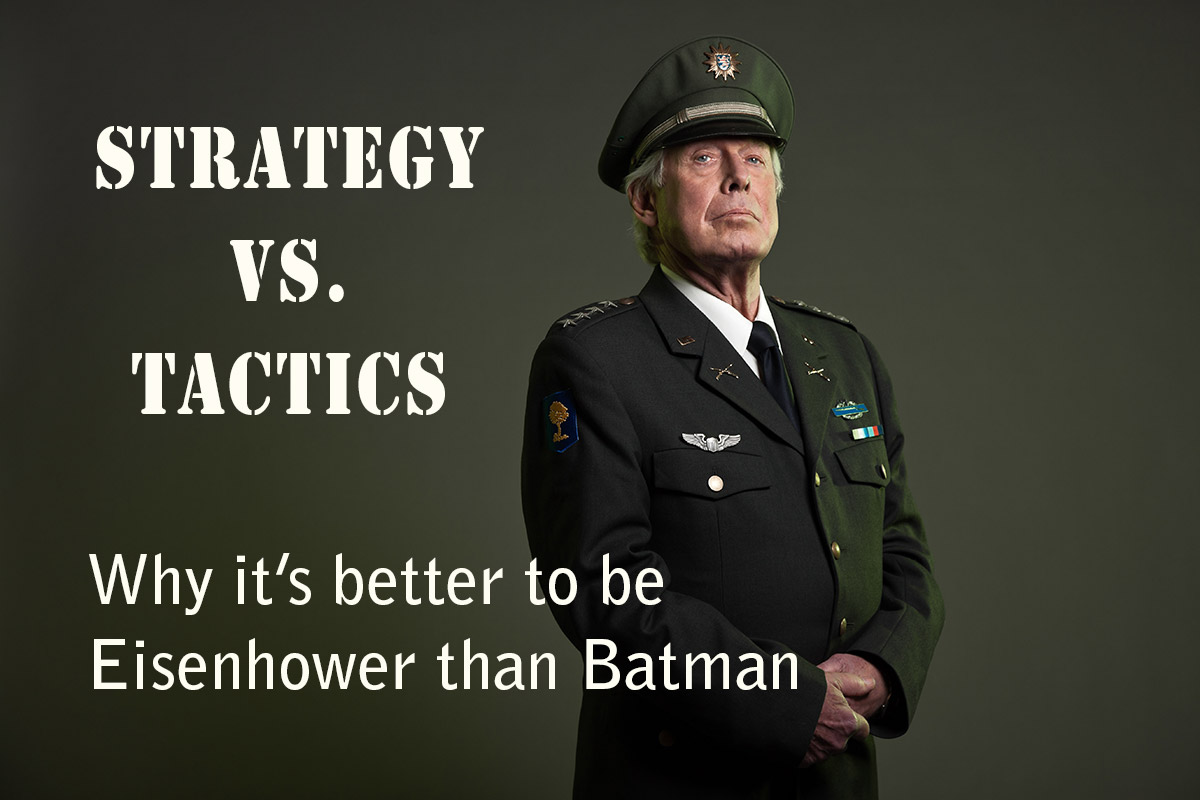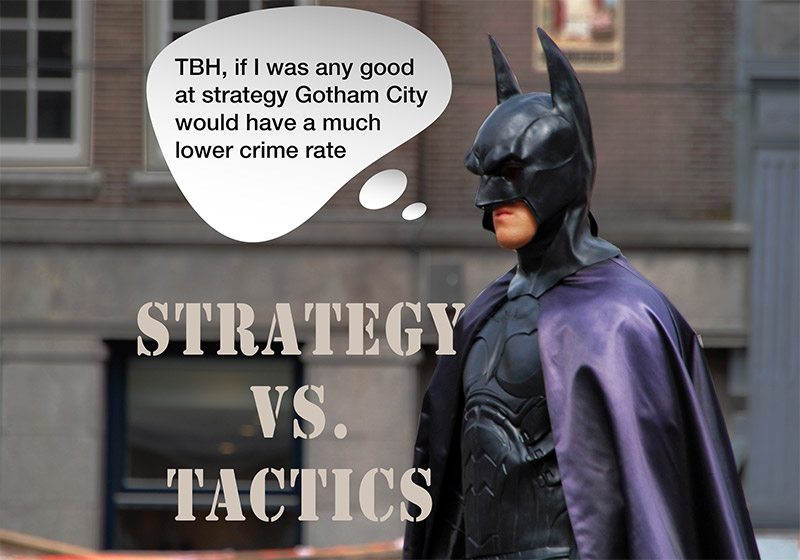In 1942 Allied commanders came together to figure out how to break Hitler’s hold on Europe. Their goal was to win the war. Their immediate objective: free France.
Their strategies:
- Invade Normandy.
- Make Hitler think they would be somewhere else.
- Weaken Axis defenses.
Among their many tactics:
- Create an elaborate campaign of deception.
- Use air bombing raids to target key offensive facilities and capabilities.
- Do extensive reconnaissance, including soliciting millions of holiday snapshots and postcards to get visuals of the landing sites and planned invasion routes.
- Develop new technologies and vehicles to overcome challenges of logistics and terrain.
- Land 160,000 troops on June 6, 1944, and have an additional 1.8 million in Europe by the end of August.
What Eisenhower, Montgomery, and the other commanders most definitely did not do was to say, “Hey, let’s take 160,000 guys over to France on Tuesday and see what happens.” Or, “We’ve got these cool amphibious vehicles. Shall we try them out in Normandy and see if we can defeat Hitler?”
Instead, every one of the thousands of tactical decisions made in the two years leading up to D-Day, in what has been called a “masterpiece of planning”, was made in support of the chosen strategies, and designed to help achieve their objective.
“GOST” (Goals, Objectives, Strategies, Tactics) = the formula for success.
Goals are the big picture ideas of what you want to do.
Objectives are specific steps that can help you achieve your goals.
Strategies are the broad strokes or paths by which you intend to achieve your objectives.
Tactics are how you’ll execute your strategies so that they actually happen.
When you skip strategy, what’s left is a tactics-first approach. Tactics-first feels like you’re doing something, but it rarely succeeds. More often, a tactics-first approach diverts your time, budget, and attention away from your objectives, and the results are disappointing.
Why would someone do tactics-first?
- It feels quicker.
- It feels easier.
- It’s more exciting.
- It masquerades as opportunity.
Let’s take these one at a time.
It feels quicker
Why spend all that time planning an ad campaign when you can jump right in and shoot a cell-phone video that will surely go viral? You know it will work because your CEO is a visionary that everyone wants to hear from, and Bob in Accounting is hilarious. When you’re done you’ll just post it on your company’s social media and wait for the magic to happen. Right? Right???
It feels easier
Developing a marketing plan and writing a creative brief often require answers to tough questions: what do our customers/donors/clients/prospects think about us? What do we want them to think about us? Why did our past efforts succeed, or fail? Are we really reaching them via the best media for them?
Decision-makers don’t avoid this work because they’re lazy. (Do you know any lazy-but-effective organization leaders? I don’t.) They avoid it for a host of other reasons that include being seriously swamped with other tasks, and not knowing how to begin.
Answering these questions and planning a strategy makes all the tactical steps that follow easier and more effective. What you gain in confidence about your marketing efforts — and what you gain in results — is a huge benefit. Pro tip: Having an experienced guide on this journey is incredibly helpful.
It’s more exciting
Nerds plan. Action-heroes jump in with superpowers blazing. Who wouldn’t rather be James Bond than the engineers who designed his gadgets?
Unfortunately, there’s a fundamental problem with action heroes: they’re reactive, not pro-active. Being able to jump in and take decisive action is valuable and necessary during a crisis. But if it’s your day-to-day operating method, putting tactics ahead of strategy is exhausting, unproductive, and keeps your team from finishing projects with more value and staying power. Reactive businesses are always chasing their competitors. Pro-active businesses become market leaders and make competitors chase them.
Worse, while it’s an adrenaline rush to think that you pulled out all the stops at the last minute and made something happen, that momentary success isn’t likely to translate into progress that meets your larger goals. Batman rushes in to defeat every colorfully-outfitted criminal who descends on his town, and yet Gotham City is still a magnet for supervillains. Eisenhower would have busted Batman down to Private years ago, and replaced Commissioner Gordon with someone who knows how to make the most of resources while leveraging their team’s skills and strengths for maximum results.
It masquerades as opportunity.
Whether it’s a business or nonprofit, a typical organization has financial objectives (how much money you’re going to earn or raise) and a budget for marketing — but no plan. Sometimes they have a marketing calendar, so they think they have a plan, but they don’t.
So now you have objectives in the back of your head, nagging at you to meet them. You know you need to start doing something, and as the deadlines loom closer — year-end review, report to the Board, financial obligations you must meet by generating revenue — the “something” you think you should be doing turns into a desperate search for “anything.” Along comes a tactical opportunity — a persuasive sales rep, a business networking opportunity, a sponsorship in the right neighborhood, a really cool premium (that jump drive shaped like a wine bottle).
What you should do is test the opportunity by reviewing your marketing plan and creative brief and seeing if the opportunity fits into your plan. Without a plan, you might decide to just go for it. If it wasn’t too expensive and doesn’t work, oh, well, at least you gave it a shot, and you can try something else. One problem with this approach is that the tactical effort might only be good one time, and not contribute to your larger goals. Another, much worse problem, is that if you do it too often, you eventually use up your budget and be no better off than before you started spending time and money.
Planning also helps you recognize when a just-discovered tactic is an opportunity

The flip side of a tactics-first approach is that without a plan, you’re just as likely to turn down a good tactic as you are to jump on a bad one. Let’s take our wine-bottle-shaped jump drive. If it has no thematic connection to your organization’s mission, products, target audience, or existing marketing, and/or if it’s going to be difficult or expensive to fulfill, it’s probably a waste of money.
On the other hand, let’s say that your marketing plan already includes a strategy of making it more convenient for your customers to get product information, and a tactic of moving from printed to digital catalogs. Your plan also includes a strategy of nurturing your high-value customers, with a tactic of holding a customer-appreciation dinner.
Now when you stumble across a wine-bottle jump drive, you know from your planning that it has potential. “Let’s make sure that the customer-appreciation dinner includes a wine tasting,” you say. “We’ll put the new digital catalogs on the drives, along with a video thank-you, and give one to each guest at the dinner.” Your plan helped you recognize a good tactical opportunity that supports and enhances your strategy.
What Strategies & Tactics Look Like In Real-World Marketing
 Here are examples of how to properly use strategies and tactics in two situations:
Here are examples of how to properly use strategies and tactics in two situations:
Non-profit
Objective: Raise twice as much in donations this year as last year.
Strategies you might choose:
- Make existing large-dollar donors feel valued.
- Attract new large-dollar donors.
- Solicit sponsorships from businesses.
- Enlarge your pool of supporters by attracting new smaller donors who may become bigger donors later.
Tactics you might choose:
- Personal outreach to existing donors to let them know they’re valued.
- While you’re talking to them, find out what they love about being donors (galas, recognition, benefits) and do more of that.
- Evaluate your donor data to see what existing large-dollar donors have in common, so you can get more like them.
- Develop a program that makes a business case for sponsorships.
- Develop offer tiers and a plan to reach small-dollar donors.
Business
Objective: Launch a new product line, with a specific number of units sold in the first 12 months.
Strategies you might choose:
- Sell the new product to existing customers.
- Sell the new product to new customers in previously untapped markets.
- Use the new product to increase your brand recognition in the marketplace.
Tactics you might choose:
- Offer existing customers a special introductory price.
- Debut the product at one or more important trade shows.
- Take your product on a demo tour. Invite industry leaders, bloggers, and influencers, and film their reactions.
- Create a video demo of your new product, and include excerpts from your demo tour.
- Promote positive reviews in digital ads.
- Update your branding to position your company as industry innovators.
Be Eisenhower, not Batman. Your bottom line will thank you.



